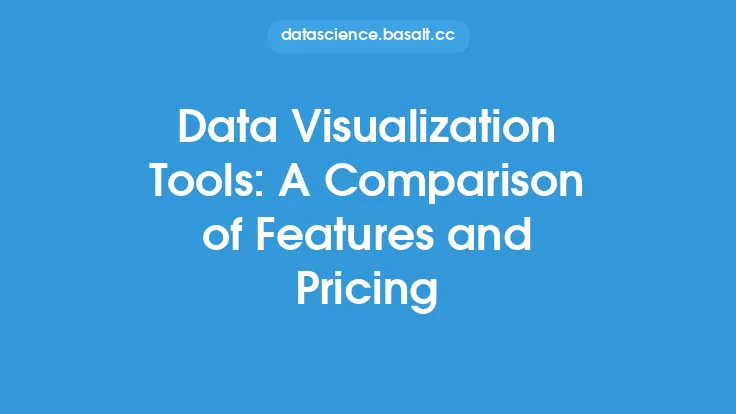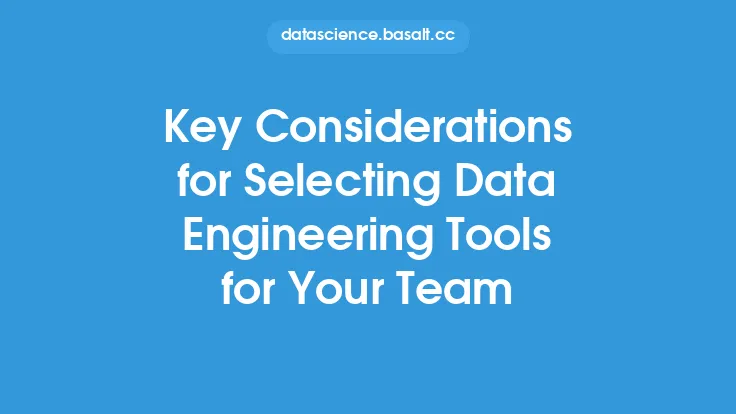The field of data engineering has experienced significant growth in recent years, driven by the increasing demand for big data analytics and the need for efficient data processing systems. As a result, a wide range of data engineering tools has emerged, offering various features and functionalities to support the development, deployment, and management of data-intensive applications. In this article, we will delve into the world of data engineering tools, comparing open-source and proprietary options, and exploring their strengths, weaknesses, and use cases.
Introduction to Data Engineering Tools
Data engineering tools are software applications designed to support the data engineering process, which involves designing, building, and maintaining large-scale data systems. These tools can be categorized into several types, including data integration tools, data processing tools, data storage tools, and data governance tools. Each type of tool serves a specific purpose, such as extracting data from multiple sources, processing and transforming data, storing data in a scalable and secure manner, and ensuring data quality and compliance.
Open-Source Data Engineering Tools
Open-source data engineering tools have gained popularity in recent years due to their flexibility, customizability, and cost-effectiveness. Some popular open-source data engineering tools include Apache Beam, Apache Spark, Apache Kafka, and Apache Hadoop. These tools offer a wide range of features, such as data processing, data integration, and data storage, and are widely used in the industry.
Apache Beam, for example, is a unified data processing model that allows developers to define data processing pipelines and execute them on various execution engines, such as Google Cloud Dataflow, Apache Spark, and Apache Flink. Apache Spark, on the other hand, is a fast and general-purpose data processing engine that supports batch and stream processing, as well as machine learning and graph processing.
Proprietary Data Engineering Tools
Proprietary data engineering tools, also known as commercial data engineering tools, are software applications developed and licensed by companies. These tools often offer advanced features, support, and security, but can be expensive and inflexible. Some popular proprietary data engineering tools include Google Cloud Data Fusion, Amazon Web Services (AWS) Glue, and Microsoft Azure Data Factory.
Google Cloud Data Fusion, for example, is a fully managed enterprise data integration service that allows developers to integrate data from multiple sources, transform and process data, and load data into various targets, such as Google Cloud Storage and Google BigQuery. AWS Glue, on the other hand, is a fully managed extract, transform, and load (ETL) service that makes it easy to prepare and load data for analysis.
Comparison of Open-Source and Proprietary Data Engineering Tools
When it comes to choosing between open-source and proprietary data engineering tools, there are several factors to consider. Open-source tools offer flexibility, customizability, and cost-effectiveness, but often require significant expertise and resources to implement and maintain. Proprietary tools, on the other hand, offer advanced features, support, and security, but can be expensive and inflexible.
In terms of scalability, open-source tools like Apache Spark and Apache Hadoop are designed to handle large-scale data processing and storage, while proprietary tools like Google Cloud Data Fusion and AWS Glue offer scalable and managed services. In terms of security, proprietary tools often offer advanced security features, such as encryption and access control, while open-source tools rely on community-driven security patches and updates.
Use Cases for Data Engineering Tools
Data engineering tools have a wide range of use cases, from data integration and data processing to data storage and data governance. Some common use cases include:
- Data warehousing: Data engineering tools can be used to build and manage data warehouses, which are centralized repositories that store data from multiple sources.
- Real-time analytics: Data engineering tools can be used to build real-time analytics systems, which process and analyze data as it is generated.
- Machine learning: Data engineering tools can be used to build and deploy machine learning models, which require large amounts of data to train and test.
- Data governance: Data engineering tools can be used to ensure data quality, security, and compliance, which are critical in regulated industries like finance and healthcare.
Best Practices for Implementing Data Engineering Tools
When implementing data engineering tools, there are several best practices to follow. First, it is essential to define clear requirements and use cases, which will help determine the type of tool needed and the features required. Second, it is crucial to evaluate the scalability, security, and performance of the tool, which will ensure that it can handle large amounts of data and meet the needs of the organization. Third, it is important to consider the total cost of ownership, which includes the cost of the tool, as well as the cost of implementation, maintenance, and support.
Conclusion
In conclusion, data engineering tools are essential for building and managing large-scale data systems, and there are many open-source and proprietary options available. When choosing a data engineering tool, it is essential to consider factors like scalability, security, and cost, as well as the specific use case and requirements of the organization. By following best practices and evaluating the strengths and weaknesses of each tool, organizations can ensure that they select the right data engineering tool for their needs and achieve their data-driven goals.





